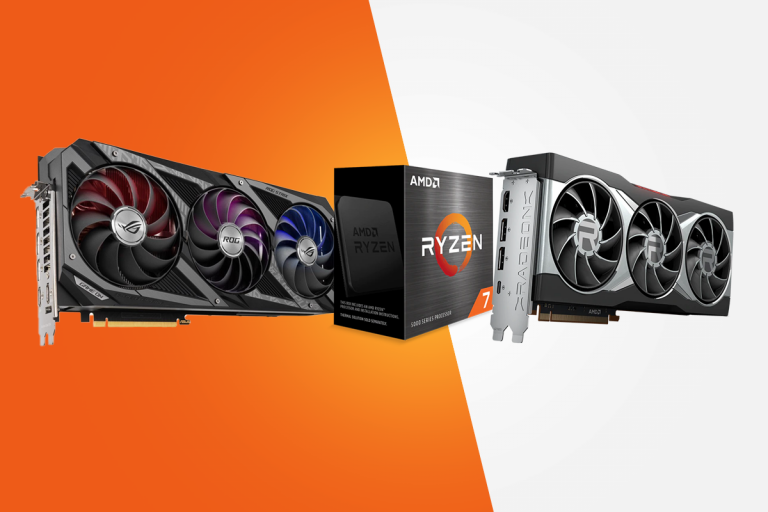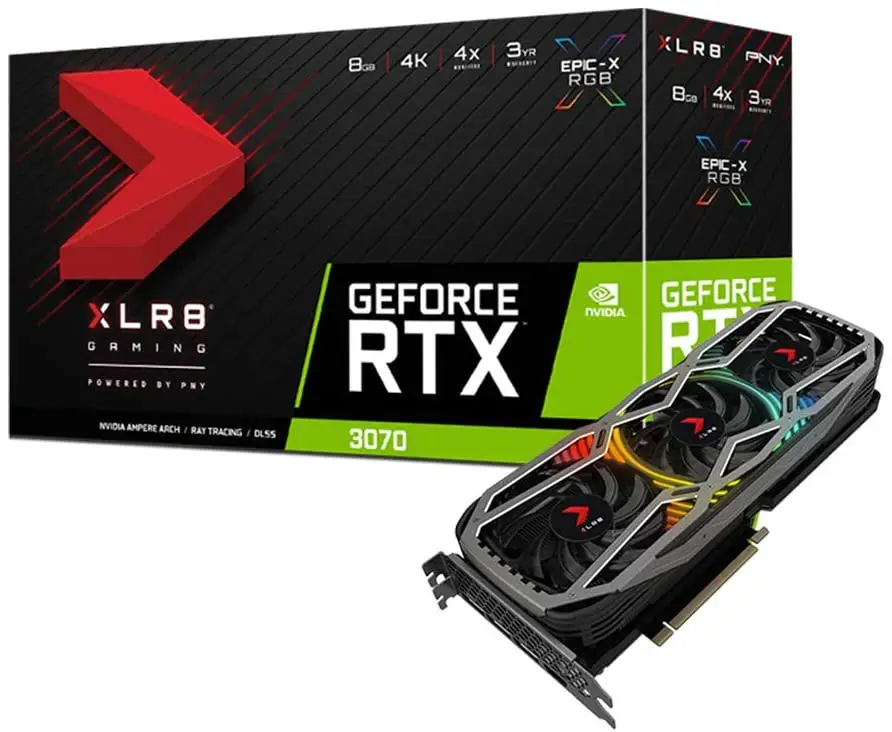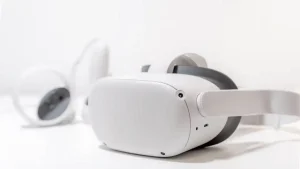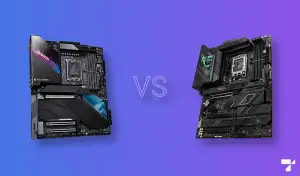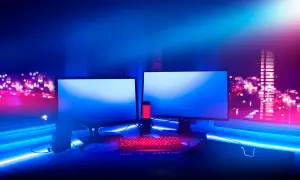AMD’s next-gen Ryzen 5000 CPU series is set to launch on November 5 and we’re all excited to try out all the new possible PC builds. However, the Ryzen 7 5800X looks particularly interesting as it’s set to rival Intel’s i9-10900K processor while being significantly cheaper. The new Zen 3 CPUs are opening up a whole new realm of affordable high-end gaming and the 5800X certainly deserves its time in the spotlight. So we’re going to explore only the best GPUs for Ryzen 7 5800Xto unlock its full potential.
AMD brought a series of improvements to the 5800X compared to its predecessor, the 3800XT, and we’re going to see a nearly 20% performance boost, despite the fact that the two processors have nearly identical specs. With 8 cores and a maximum boost speed of 4.7GHz, AMD demonstrates that the new Zen 3 architecture is superior to the previous generation. Therefore, your system will definitely benefit from such an upgrade, even if you get your hands on the middle of the pack 5800X CPU.
With that being said, let’s take a look at the 7 best GPUs that are worth teaming up with the Ryzen 7 5800X.
7 Best GPUs for Ryzen 7 5800X
1. AMD Radeon RX 6800 XT Graphics
Specifications:
Stream Processors: 4,608 | Base/Boost Clock: 2015 MHz/2250 MHz | Memory: 16 GB GDDR6 | Memory Clock: 16Gbps | Power Connectors: 2x PCIe 8-pin | Outputs: 1x HDMI 2.1 VRR and FRL, 2x DisplayPort 1.4aKey features:
- Radeon Image Sharpening
- Radeon Anti-Lag
- Ray Tracing support
- Smart Access Memory
- Radeon Boost
The RX 6800XT is the boosted version of the 6800 edition and it’s designed for 4K gaming, just like its direct rival the RTX 3080. For a slight price increase from the base 6800 version, we’re getting more stream processors, a higher TFLOPs throughput, and a higher base/boost clock. The price difference between the two is fairly marginal, so it’s definitely worth getting the XT edition, especially if interested in building a 4K setup. Furthermore, while this GPU is comparable in specs with the RTX 3080 and thus delivering a similar performance, AMD is undercutting Nvidia, offering a slightly better price.
Next to higher clock speeds and a higher stream processor count, the XT edition comes with the same software improvements as its more docile form, the RX 6800. Ray tracing, super sampling, and variable-rate shading.
In conclusion, if you’re looking for a budget-friendly 4K setup, the RX 6800XT is a great GPU to pair with the Ryzen 5800X to take full advantage of AMD synergy. Between the base edition and the XT edition the price difference is more than worth it.
2. Nvidia Geforce RTX 3070
Specifications:
Stream Processors: 5,888 | Base/Boost Clock: 1500 MHz/1730 MHz | Memory: 8 GB GDDR6 | Memory Clock: 14Gbps | Power Connectors: 1x PCIe 8-pin | Outputs: 1x HDMI 2.1, 3x DisplayPort 1.4aKey features:
- Nvidia DLSS (Deep Learning Super Sampling)
- Ray Tracing
- Nvidia Reflex
- PCI Express 4.0 support
- VR Ready
- Nvidia Broadcast
What’s better to pair with a next-gen Zen 3 CPU other than a next-gen RTX 3000s GPU? Anyone who’s looking for a high performing future-proof setup should grab the Ryzen 5800X alongside an RTX 3070.
Nvidia’s RTX 3070 is an affordable powerhouse that rivals the previous generation’s flagship, the 2080 TI while being sold at half the price. For most gamers and 4K enthusiasts, the performance offered by the 3070 with its 8GB of GDDR6 memory and a maximum clock speed of 1730 MHz is more than enough. With the new Ampere design, Nvidia was able to fit twice as many CUDA cores than the 2070 predecessor sported, so we get to enjoy high rasterization performance and boosted ray tracing at lower costs. And as the cherry on the cake, the RTX 3070 isn’t as power-hungry as its bigger brother, the RTX 3080, demanding only 220W of power. In addition, the RTX 3070’s PCI 4.0 support matches the Ryzen 7 5800X’s PCI 4.0 support, so we’ll be able to take full advantage of this new feature.
But that’s not all. The 3070 isn’t just a powerful piece of hardware. It also comes with a series of software improvements that are great to have when gaming as well as in other situations, such as at work during a conference call. This GPU benefits from the RTX IO tech that’s intended to boost the data delivery speed in collaboration with the DirectStorage API from Microsoft. In other words, the GPU will not be held back by the CPU because data will be sent from the SSD straight to the GPU.
Furthermore, the package includes Nvidia Broadcast together with RTX Voice, allowing the user to manipulate the background during a video call and to remove most background noise as well. This is essential for streamers and for anyone who uses the computer as a communication device.
In essence, the RTX 3070 is one of the best options when considering a new PC build with the Ryzen 7 5800X.
3. AMD Radeon RX 6800 Graphics
Specifications:
Stream Processors: 3,840 | Base/Boost Clock: 1815 MHz/2105 MHz | Memory: 16 GB GDDR6 | Memory Clock: 16Gbps | Power Connectors: 2x PCIe 8-pin | Outputs: 1x HDMI 2.1 VRR and FRL, 2x DisplayPort 1.4aKey features:
- Radeon Image Sharpening
- Radeon Anti-Lag
- Ray Tracing support
- Smart Access Memory
- Radeon Boost
With AMDs exciting announcement about the new RX 6000 series of graphics cards many of us are looking forward to trying out a high-end AMD build. The RX 6800 is the mid-range entry on the list of next-gen graphics cards, giving us an alternative to Nvidia’s 3000 series.
Based on the initial benchmark scores released by AMD, the RX 6800 seems to be designed to overtake the RTX 2080 TI and to compete with the RTX 3070. What’s even more exciting, however, is that AMD designed their new line of GPUs to perform even better when paired with one of their new Zen 3 processors, like the Ryzen 7 5800X. So if you’re going to get a Ryzen 5000 series processor, you’ll benefit from the Smart Access Memory feature, a performance booster, which only works when this GPU is paired with a Zen 3 processor.
While AMD lagged behind Nvidia in the GPU department, they got back in the race by marking their entry with the RX 6800, a GPU with 16GB GDDR6 memory, 16 TFLOPs throughout, and an impressive 2105 MHz boost clock. In addition to these impressive specs, AMD has also added ray tracing support, which they previously lacked when compared to Nvidia’s line of GPUs, and further improved performance with variable-rate shading and denoising software.
In essence, the RX 6800 is a great 4K-capable choice, especially when already planning to purchase a Ryzen 7 5800X or any of the other 5000 series CPUs.
4. Nvidia Geforce RTX 3080
Specifications:
Stream Processors: 8,704 | Base/Boost Clock: 1440 MHz/1710 MHz | Memory: 10 GB GDDR6X | Memory Clock: 19Gbps | Power Connectors: 2x PCIe 8-pin | Outputs: 1x HDMI 2.1, 3x DisplayPort 1.4aKey features:
- Nvidia DLSS (Deep Learning Super Sampling)
- Ray Tracing
- Nvidia Reflex
- PCI Express 4.0 support
- RTX I/O
- Nvidia Broadcast
Nvidia made a giant leap for gamers everywhere with the RTX 3080 that delivers nearly 30% higher performance than its predecessor, the 2080 TI, while being offered at nearly half the price. This GPU is one of the best choices for 4K gaming, as well as workstations thanks to the high number of CUDA cores (around twice as many as the 2080) and its outstanding 29.7 TFLOPs throughputs. This also means that the performance of Nvidia’s deep learning super sampling has been significantly boosted.
The features that come with the RTX 3080 are just as impressive as the technical specs. The most exciting one has to be RTX I/O, an API designed to operate together with the DirectStorage API from Microsoft. This feature is important because it allows data to be transferred from the SSD to the GPU directly. As a result, we’re going to experience much shorter loading times, particularly in future games. The downside is that developers have to design the game around this technology in order to benefit from it, so it may take some time before we can enjoy all the advantages that come with it.
All in all the RTX 3080 is one of the best choices on the market for those who are looking for a great 4K gaming experience and anyone who wants to future-proof their PC. Furthermore, it’s also an inexpensive option for budget-friendly 3D modeling and machine learning workstations.
5. AMD Radeon RX 5700 XT Graphics
Specifications:
Stream Processors: 2,560 | Base/Boost Clock: 1605 MHz/1905 MHz | Memory: 8 GB GDDR6 | Memory Clock: 14Gbps | Power Connectors: 1x PCIe 8-pin and 1x PCIe 6-pin | Outputs: 1x HDMI, 3x DisplayPort 1.4Key features:
- Radeon Image Sharpening – Intelligent sharpening technology
- Radeon Anti-Lag latency reducer
- PCI Express 4.0 support
- Energy efficient
- VR Ready
While Nvidia made great leaps with their RTX 3000s series, AMD still has a few solid choices, like the RX 5700 XT. This GPU was designed to compete with the RTX 2070, however, unlike it and other GPUs, AMD developed it purely for gaming. This means that the RX 5700 XT will perform phenomenally well in games even when compared to certain GPUs that have higher clock speeds. This level of performance is possible thanks to the 7nm architecture combined with a few gaming-focused software features.
Radeon Image Sharpening is one of the most important features, made to rival Nvidia’s deep learning super sampling technology (DLSS). It’s capable of intelligently improving the quality of the graphics because it contrasts awareness, so it doesn’t act like a plain sharpening filter. Its main purpose is to prevent the generation of bad textures and artifacts.
In combination with the Radeon Anti-Lag feature, this GPU becomes a great option for competitive gamers especially, as well as streamers. Nobody likes lag, and thankfully this bit of technology prevents lag by telling the processor to wait for the graphics card to be ready to send more frames. In other words, we end up eliminating the frame buffer and therefore reducing the input lag.
In essence, the RX 5700 XT is one of the best choices, together with the Ryzen 7 5800X, for those interested in gaming in particular. However, take note that it’s not the ideal solution for 4K gaming because the card simply isn’t built for that. At that level, we can expect medium to high settings at best.
6. AMD Radeon RX 5600 XT Graphics
Specifications:
Stream Processors: 2,304 | Base/Boost Clock: 1130 MHz/1560 MHz | Memory: 6 GB GDDR6 | Memory Clock: 14Gbps | Power Connectors: 1x PCIe 8-pin | Outputs: 1x HDMI, 3x DisplayPort 1.4Key features:
- Radeon Image Sharpening – Intelligent sharpening technology
- Radeon Anti-Lag latency reducer
- Radeon Boost
- PCI Express 4.0 support
- Energy efficient
The RX 5600XT isn’t a top of the line GPU and it doesn’t come with ray tracing technology either, but it offers a great 1080p gaming experience for those restricted by their budget. The purpose of this graphics card is to supply us with plenty of raw power, and it certainly does, just not for 4K setups.
Like the other AMD cards in the 5000 series, this GPU is built using the 7nm manufacturing process, and therefore it performs impressively well despite its size and the small amount of power it needs. And while it comes with only 6GB of GDDR6 memory, the 5600XT comes with a variety of software features to improve our gaming experience.
The most important feature is Radeon Boost, especially for competitive gamers. Its purpose is to reduce the background resolution while the camera isn’t stationary. This way the GPU can significantly increase the frame rates without distorting or diminishing the quality of the graphics. In combination with the Anti-Lag technology, the 5600XT becomes a highly efficient GPU that extracts every drop of performance it can offer. And while it’s not powerful enough for a 4K gaming system, this midrange card is great for those who are interested in a high quality 1080, or even 1440p experience.
7. Nvidia Geforce RTX 2070 Super
Specifications:
Stream Processors: 2,560 | Base/Boost Clock: 1605 MHz/1770 MHz | Memory: 8 GB GDDR6 | Memory Clock: 14Gbps | Power Connectors: 1x PCIe 8-pin and 1x PCIe 6-pin | Outputs: 1x HDMI 2.0b, 3x DisplayPort 1.4aKey features:
- Nvidia DLSS (Deep Learning Super Sampling)
- Ray Tracing
- Nvidia Adaptive Shading
- Nvidia SLI-Ready
- VR Ready
The RTX 2070 Super is a boosted 2070 card that almost reaches the same performance of the RTX 2080. This card is aimed towards the average gamers that don’t go beyond 1440p resolutions. It’s also a good choice for 3D modelers on a budget who don’t need a beefy setup for a great deal of rendering.
The Super edition comes with a higher number of CUDA cores as well as higher base and boost clock speeds, thus offering better performance to price ratio than the base edition. Furthermore, this GPU comes with most of the software features we see in the 3000 series, so we can benefit from improvements such as ray tracing and DLSS without breaking the bank.
However, despite the great technical specs and software enhancements, the RTX 2070 Super feels a bit outdated with the launch of its 3070 counterparts, mainly because of the price. Both GPUs cost nearly the same, but the RTX 3070 is significantly more powerful and adequate for 4K gaming as well. So even though the 2070 Super edition is a good choice when paired with the 5800X CPU, getting the 3070 is a better option at least until prices drop further for the 2000 series GPUs.
Final Thoughts
While AMD lagged behind in the GPU department, this year might become their year. With the launch of the new Zen 3 processor series combined with the 6000 series of GPUs, we can finally build a future-proof AMD setup. However, that doesn’t mean we should neglect the choices offered by Nvidia. Both the RTX 3070 and 3080 are amazing choices for a gaming build powered by Ryzen 7 5800X. Lastly, you can check this bottleneck calculator to better determine which of the GPUs above is best for your Ryzen 7 5800X.
